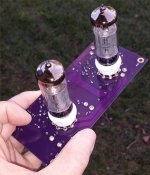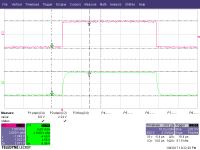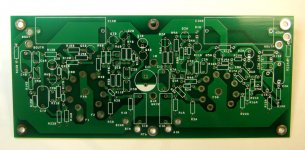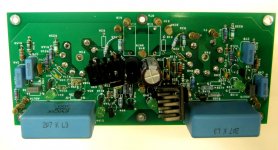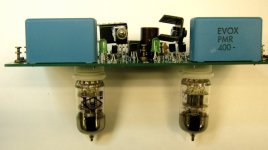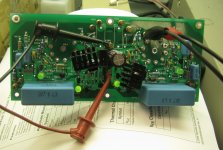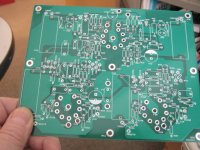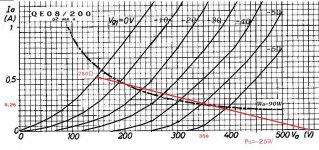Here's the top side. The filaments light up, I'll try to light up the rest of it some time this week. If the static voltages check out alright, the rest should work. I did a somewhat simpler version of this circuit in breadboard form in my "Evil Sandman" thread that did just fine.
Attachments
Last edited:
Here's the original "Evil Sandman" thread for reference.
http://www.diyaudio.com/forums/analog-line-level/155459-evil-sandman-preamp.html
http://www.diyaudio.com/forums/analog-line-level/155459-evil-sandman-preamp.html
Here's board for the next module. a feedback-based RIAA preamp designed around the 6N3P-EV with sand helpers. The front end is cascoded to ease capacitive loading for finicky MM cartridges (high-end AT cartridges come to mind).
It's not a cool swooky purple board like the line amp module, but it's cheap, and will do just fine.
It's not a cool swooky purple board like the line amp module, but it's cheap, and will do just fine.
Attachments
Another view. When all is debugged, I will do custom heat sinks or reconfigure PCB to make room for std heat sink. The heat sinks are mounted sideways so they'll fit. Since all the big components will hang down into the chassis one the board is in place, this is not a real aesthetic issue for now.
Attachments
Fired up board with bench supplies. Filaments light up (easy part). Dropper LEDs light up on both second stages (sign of good health), and I get about 35V DC output level before the coupling cap (expected). The cascoded input stages (both of them) didn't light up at all. Digging into this problem I learned some interesting tidbits about the design philosophy for the chosen topology, applied changes, and got one input stage to light and deliver 45V DC before the coupling cap (expected). I'll fix the other input stage when I get some spare time. It better sound nice...
Power amp layout is pretty much complete. The design is similar to Pete Millett's "E-linear", but uses a much more humble pentode for the input stage, and there's a follower slung between the input and output stages. I'll be using 6L6GC for outputs, so am expecting at most ~8W output. I have a pair of 5k Transcendar output transformer with ultralinear tap that will serve well to test the completed amp, assuming I can find the transformers in the basement.
I got the power amp PCB last week, and I'm busy bringing up the amp with tubes in place but without the output XFMRs, in order to get the bias voltages and currents settled in. More info on that later. Today, more thrills & spills - my new RIAA/line amp combo board came in - here's a look.
Attachments
Wrench , You've got more sand then mine, I used 2SC1815 as first stage giving a gain of 40 into RIAA then 6922 as second stage.
I am toying with adding more ( tube ) gain to drive 6922 harder and then divide the final output to the correct level. 12AX7 plus NPN buffer may work as well
This setup has little microphonics and very low noise.
6922 can also drive 47k load with no buffer
I am toying with adding more ( tube ) gain to drive 6922 harder and then divide the final output to the correct level. 12AX7 plus NPN buffer may work as well
This setup has little microphonics and very low noise.
6922 can also drive 47k load with no buffer
Last edited:
I wanted no fancy-pants audio boutique tubes in my setup (6DJ8/6922 qualifies these days), or any pitiful starvling 12AX7s. The only "popular" tubes will be the 6L6GCs in the power amp, chosen on the basis of plate dissipation vs. filament draw. I may do a P-P version down the line using 6L6GCs or 7591As as finals.
I wanted no fancy-pants audio boutique tubes in my setup (6DJ8/6922 qualifies these days), or any pitiful starvling 12AX7s. The only "popular" tubes will be the 6L6GCs in the power amp, chosen on the basis of plate dissipation vs. filament draw. I may do a P-P version down the line using 6L6GCs or 7591As as finals.
Filament draw is the main reason I still prefer the 6V6 and 6L6 to many other tubes, gain is easy enough to provide in low THD to make the increased sensitivity of types like the EL84 not a huge benefit, especially if you aren't power hungry and trying to squeeze that last watt or two out...
Less heater current makes AC heaters much more feasable, less current means less radiated field, just twist your wires and dress it nicely. I for some reason always end up needing DC on EL84 types, only way to get hum out of the way...
I think the UL84 is the tube for you, 100mA heaterLess heater current makes AC heaters much more feasable, less current means less radiated field, just twist your wires and dress it nicely. I for some reason always end up needing DC on EL84 types, only way to get hum out of the way...
Mona
Class A and filament draw considerations immediately ruled out sweep tubes (even though the price is right), as any sweep tube with 30W plate dissipation wants 2.5A or more on the filament. The hefty cathode in your average sweep tube is not used to advantage for a single-ended Class A design anyway. Save them for monster P-P designs.
I may try a KT88 in my next build of the power amp to try and squeeze out an honest 10W of single-ended power. Same board, slightly different stuffing and operating point.
I may try a KT88 in my next build of the power amp to try and squeeze out an honest 10W of single-ended power. Same board, slightly different stuffing and operating point.
You could consider a QE8/200.Class A and filament draw considerations immediately ruled out sweep tubes (even though the price is right), as any sweep tube with 30W plate dissipation wants 2.5A or more on the filament. The hefty cathode in your average sweep tube is not used to advantage for a single-ended Class A design anyway. Save them for monster P-P designs.
I may try a KT88 in my next build of the power amp to try and squeeze out an honest 10W of single-ended power. Same board, slightly different stuffing and operating point.
Allmost a 2.5x KT88, plate diss.100W, heater 6.3V 3.9A and triode strapped 0.5A @ 150V max.(Vg1=0V).
Mona
Attachments
I think the UL84 is the tube for you, 100mA heater
Mona
Neat tube.
Thanks, now I've got another to add to the list.
I'm not considering any tubes that are difficult to find for the finals in my amp - plain vanilla all the way. I have several flavors of 6L6GC and some EH KT88s that will do just fine.
Anything over 10W or so will be P-P rather than SE. Again, plain vanilla tubes (6L6GC or 7591A) will get me a comfortable 30W/channel or so with a 400V B+.
The extra chocolate sauce and sprinkles will be the circuitry that surrounds the otherwise proletarian tubes...
Anything over 10W or so will be P-P rather than SE. Again, plain vanilla tubes (6L6GC or 7591A) will get me a comfortable 30W/channel or so with a 400V B+.
The extra chocolate sauce and sprinkles will be the circuitry that surrounds the otherwise proletarian tubes...
- Status
- This old topic is closed. If you want to reopen this topic, contact a moderator using the "Report Post" button.
- Home
- Amplifiers
- Tubes / Valves
- Tube Integrated Amp
